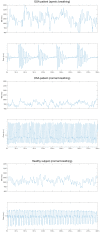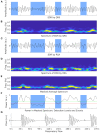The Different Facets of Heart Rate Variability in Obstructive Sleep Apnea
- PMID: 34366907
- PMCID: PMC8339263
- DOI: 10.3389/fpsyt.2021.642333
The Different Facets of Heart Rate Variability in Obstructive Sleep Apnea
Abstract
Obstructive sleep apnea (OSA), a heterogeneous and multifactorial sleep related breathing disorder with high prevalence, is a recognized risk factor for cardiovascular morbidity and mortality. Autonomic dysfunction leads to adverse cardiovascular outcomes in diverse pathways. Heart rate is a complex physiological process involving neurovisceral networks and relative regulatory mechanisms such as thermoregulation, renin-angiotensin-aldosterone mechanisms, and metabolic mechanisms. Heart rate variability (HRV) is considered as a reliable and non-invasive measure of autonomic modulation response and adaptation to endogenous and exogenous stimuli. HRV measures may add a new dimension to help understand the interplay between cardiac and nervous system involvement in OSA. The aim of this review is to introduce the various applications of HRV in different aspects of OSA to examine the impaired neuro-cardiac modulation. More specifically, the topics covered include: HRV time windows, sleep staging, arousal, sleepiness, hypoxia, mental illness, and mortality and morbidity. All of these aspects show pathways in the clinical implementation of HRV to screen, diagnose, classify, and predict patients as a reasonable and more convenient alternative to current measures.
Keywords: autonomic dysfunction; central autonomic networks; frequency-domain analysis; heart rate variability; non-linear analysis; obstructive sleep apnea; time-domain analysis; time-window analysis.
Copyright © 2021 Qin, Steenbergen, Glos, Wessel, Kraemer, Vaquerizo-Villar and Penzel.
Conflict of interest statement
The authors declare that the research was conducted in the absence of any commercial or financial relationships that could be construed as a potential conflict of interest.
Figures


Similar articles
-
Heart rate variability and obstructive sleep apnea: Current perspectives and novel technologies.J Sleep Res. 2021 Aug;30(4):e13274. doi: 10.1111/jsr.13274. Epub 2021 Jan 18. J Sleep Res. 2021. PMID: 33462936 Review.
-
Heart rate variability during wakefulness as a marker of obstructive sleep apnea severity.Sleep. 2021 May 14;44(5):zsab018. doi: 10.1093/sleep/zsab018. Sleep. 2021. PMID: 33506267 Free PMC article.
-
Cardiac autonomic control in the obstructive sleep apnea.Libyan J Med. 2015 Apr 8;10(1):26989. doi: 10.3402/ljm.v10.26989. eCollection 2015. Libyan J Med. 2015. PMID: 25861821 Free PMC article.
-
ECG and Heart Rate Variability in Sleep-Related Breathing Disorders.Adv Exp Med Biol. 2022;1384:159-183. doi: 10.1007/978-3-031-06413-5_10. Adv Exp Med Biol. 2022. PMID: 36217084
-
Obstructive sleep apnea syndrome and autonomic dysfunction.Auton Neurosci. 2019 Nov;221:102563. doi: 10.1016/j.autneu.2019.102563. Epub 2019 Jul 10. Auton Neurosci. 2019. PMID: 31445406 Review.
Cited by
-
Investigating Cardiorespiratory Interaction Using Ballistocardiography and Seismocardiography-A Narrative Review.Sensors (Basel). 2022 Dec 6;22(23):9565. doi: 10.3390/s22239565. Sensors (Basel). 2022. PMID: 36502267 Free PMC article. Review.
-
Cardiopulmonary Sleep Spectrograms Open a Novel Window Into Sleep Biology-Implications for Health and Disease.Front Neurosci. 2021 Nov 12;15:755464. doi: 10.3389/fnins.2021.755464. eCollection 2021. Front Neurosci. 2021. PMID: 34867165 Free PMC article. Review.
-
Nocturnal short-term heart rate variability reflects impaired daytime vigilance better than overnight heart rate variability in suspected obstructive sleep apnea patients.Sleep. 2025 Apr 11;48(4):zsae282. doi: 10.1093/sleep/zsae282. Sleep. 2025. PMID: 39670869 Free PMC article.
-
The Dynamics of Heart Rate Asymmetry and Situational Sleepiness from Evening to Night: The Role of Daytime Sleepiness.Biology (Basel). 2024 Oct 3;13(10):794. doi: 10.3390/biology13100794. Biology (Basel). 2024. PMID: 39452103 Free PMC article.
-
Heart Rate Variability from Wearable Photoplethysmography Systems: Implications in Sleep Studies at High Altitude.Sensors (Basel). 2022 Apr 9;22(8):2891. doi: 10.3390/s22082891. Sensors (Basel). 2022. PMID: 35458875 Free PMC article.
References
Publication types
LinkOut - more resources
Full Text Sources

